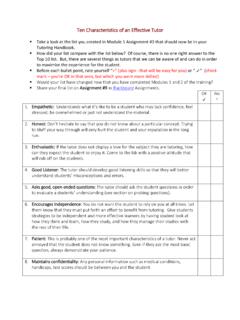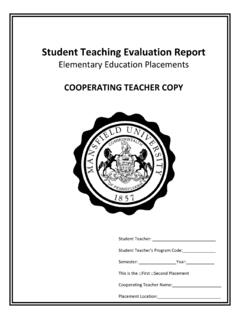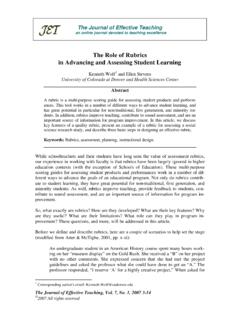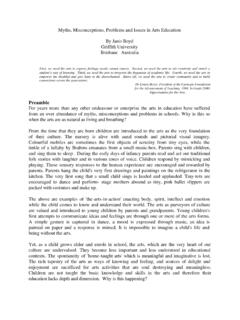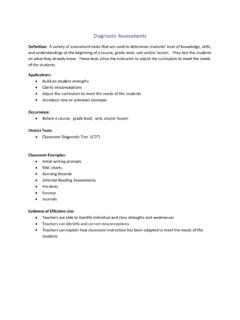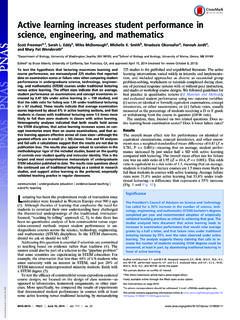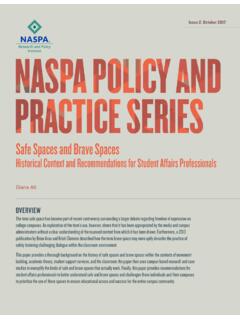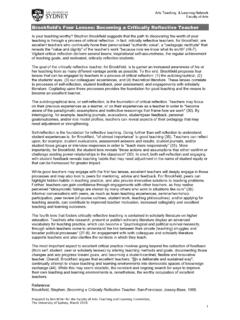Transcription of An exploration of common student misconceptions in …
1 International Education Journal, 2006, 7(4), 553-559. ISSN 1443-1475 2006 Shannon Research Press. 553 An exploration of common student misconceptions in science Fiona Thompson School of Education, University of Adelaide Sue Logue School of Education, University of Adelaide This study formed the basis of an assignment for a teacher-training course. The objectives of the study were to define three scientific concepts and identify for each some of the misconceptions that students commonly have. Six students , representing three distinct age groups were interviewed, using a predetermined set of questions and activities for each concept. student responses were recorded and evaluated in an attempt to understand what misconceptions were held by the students , how they acquired them. The study showed that the level of misconceptions varied between concepts.
2 There appeared to be some patterns in the level and type of misconceptions between the three age groups, suggesting that a more rigorous study in this area would be of value. Science, misconceptions , teacher training, students INTRODUCTION Concepts can be considered as ideas, objects or events that help us understand the world around us (Eggen and Kauchak, 2004). misconceptions , on the other hand can be described as ideas that provide an incorrect understanding of such ideas, objects or events that are constructed based on a person s experience (Martin et al., 2002) including such things as preconceived notions, non-scientific beliefs, na ve theories, mixed conceptions or conceptual misunderstandings (Hanuscin, ). Piaget suggests that children search for meaning as they interact with the world around them (see Eggen and Kauchak, 2004, ) and use such experiences to test and modify existing schemas.
3 There are many possible sources for the development of misconceptions . First, not all experiences lead to correct conclusions or result in students seeing all possible outcomes. Second, when parents or other family members are confronted with questions from their children, rather that admitting to not knowing the answer, it is common for them to give an incorrect one (Alagumalai, pers. comm.). Other sources of misconceptions include resource materials, the media and teachers ( ). The main issue is that all of the above sources are considered to be trustworthy , leading to ready acceptance by students of what they are being taught ( ). misconceptions themselves can be related to such things as misunderstanding factual information or being given conflicting information from credible sources such as parents and teachers ( ); Hanuscin, ).
4 The big issues are that once a misconception has been formed, it is extremely difficult to change (Eggen and Kauchak, 2004) and that possessing misconceptions can have serious impacts on learning (Hanuscin, ). students come into the classroom with prerequisite knowledge (existing schemas) and as they progress through their education these schemas are progressively (or sequentially) built upon 554 An exploration of common student misconceptions in science (Alagumalai, pers. comm.). In order to teach science effectively, it is vital to ensure that existing schemas are sound and to modify any misconceptions that will compromise them, following the logic that misconceptions themselves can be considered to be sequential and therefore lead to ever increasing issues with learning as students continue to build their knowledge on current understandings (Hanuscin, ; Alagumalai, pers.)
5 Comm.). There are many strategies available to help teachers modify misconceptions ( ), but before this can be achieved, the teacher needs to have strategies for identifying exactly what misconceptions a student may have. This study was undertaken as an assignment in a Junior Science Methodology course as part of a Graduate Teacher training program. As such it was more of a learning exercise rather than a true research project. The objectives of the study were to define three scientific concepts and identify for each some of the misconceptions that students commonly have. Six students of different ages were interviewed, using a predetermined set of questions and activities for each concept and their responses recorded, in an attempt to discover what the students misconceptions were, how they acquired them and whether the exercises, combined with discussion, helped to modify any such misconceptions .
6 Three examples of science concepts and their associated misconceptions are given in Table 1. Table 1. Three examples of science concepts and their associated misconceptions Scientific Concepts Associated misconceptions Whether something sinks or floats depends on a combination of its density, buoyancy, and effect on surface tension. Things float if they are light and sink if they are heavy. Clouds contain very small particles of water or ice that are held up in the air by the lifting action of air currents, wind and convection. These particles can become bigger through condensation and when they become too heavy to be held up in the air they fall to the earth as rain, hail or snow. Clouds contain water that leaks out as rain. An animal is a multicellular organism that is capable of independent movement. An animal is a land mammal other than a human being.
7 Insects, birds and fish are not animals. METHODOLOGY Subjects Six students , ranging between 6 and 15 years old were interviewed, to test both the misconceptions themselves, and whether they changed with the age of the students (Table 2). The students could be roughly split into three age groups: a) 6 to 7 years old, b) 10 years old and c) 14 to 15 years old. Table 2. Age demographic of students interviewed student Age 1 6 2 7 3 10 4 10 5 14 6 15 Approach Three different approaches were used for the interviews.
8 For Misconception 1, students tested the question using practical activities. For Misconception 2, students had to give verbal responses. For Misconception 3, a questionnaire was used (adapted from Dawson, 1997), in which, having been asked the question, students ticked off their answers on a worksheet. The aim of using three Thompson and Logue 555 different approaches was to make the interviews: a) more fun for the students , b) more informative for the interviewers, and c) allow a range styles for presenting results. In all cases, probing and clarifying questions were used in an attempt to identify the bases for the students responses. student interviews: The student interviews were divided into four parts. 1. students were asked a question or series of questions. 2. students were asked to answer or test the question(s).
9 3. students answers or discoveries were discussed with the interviewer. 4. students were asked to answer further, or test discoveries again. The approaches for the student interviews were as follows. Misconception 1: Things float if they are light and sink if they are heavy. 1. Why do some things float and some things sink? 2. Feel these two items. (Metal and plastic spoons of the same size). Which is heavier? Will they float or sink? Why? Test this to see whether you were right. Why was it so? 3. What about these two items? (Small metal pin/drawing pin and large plastic spatula/chopstick) Will they float or sink? Why? Test this to see whether you were right. Why was it so? 4. What about these two items? (Metal lid and plastic animal). Will they float or sink? Why? Test this to see whether you were right. Why was it so? 5. What about these two items?
10 (Two plastic animals of the same size) Will they float or sink? Why? Test this to see whether you were right. Why was it so? 6. Discuss. Misconception 2: Clouds contain water that leaks out as rain. 1. What is a cloud? 2. What makes up a cloud and how does it form? 3. How does rain get out of clouds? 4. What happens to the cloud when it rains? 5. Discuss. Misconception 3: Birds, fish and insects are not animals. 1. What is an animal? 2. Look at the worksheet and tick whether you think each thing listed is an animal, plant or something else. 3. How did you decide on these answers? 4. Discuss. 5. Would you change any of your answers? RESULTS Misconception 1: Things float if they are light and sink if they are heavy Why do some things float and some things sink? In response to the initial question of why some things float and some things sink, four out of six of the students initially explained sinking and floating in terms of weight.










